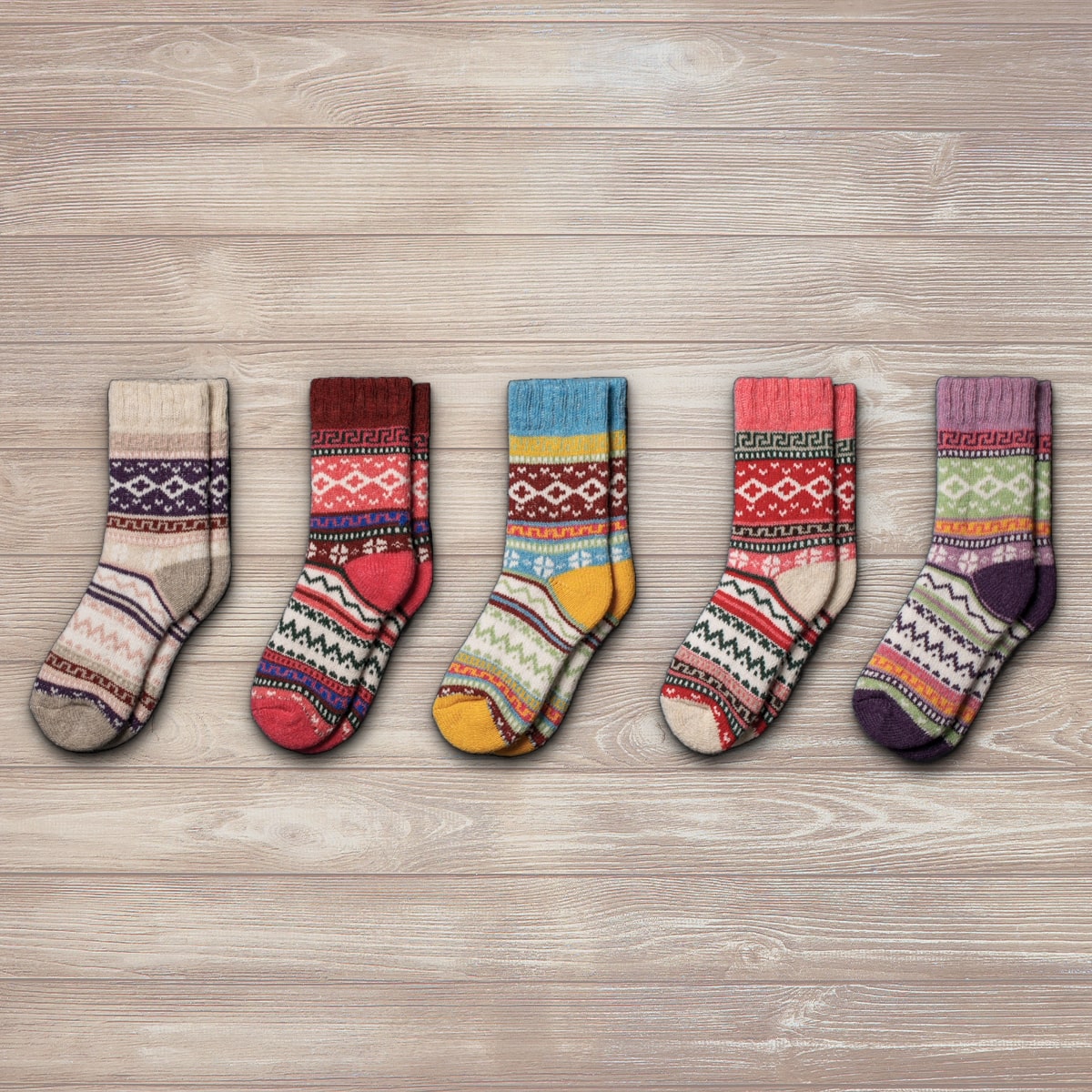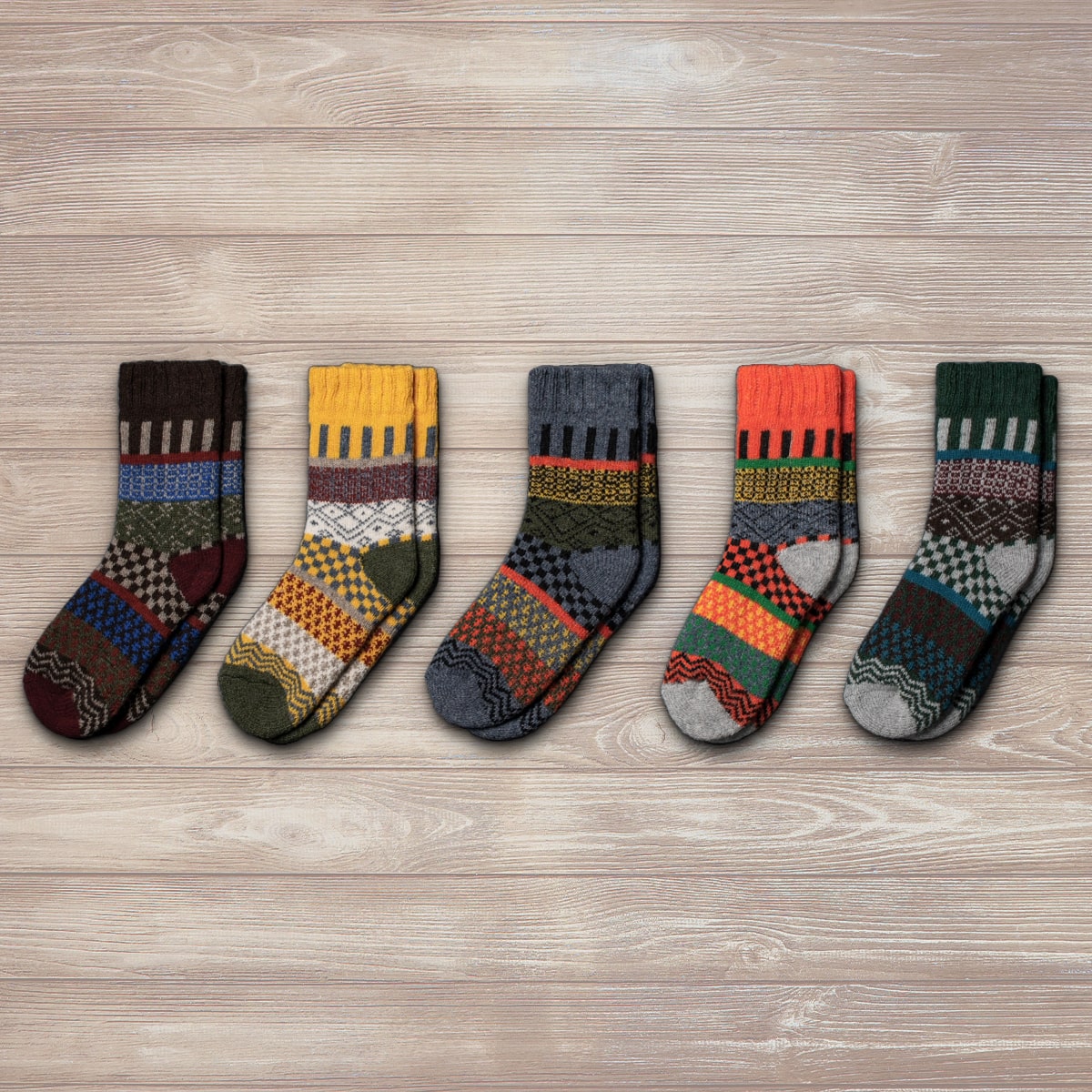Your Cart is Empty

Wool vs Cotton Socks for Hiking: Which is the Best Material for Hiking Socks?
7 min read
These days, ''take a hike'' is a positive statement, not a dismissive one. This increasingly popular hobby needs some footwear to match. Socks can also create a conundrum because some opine that the best socks for hiking are woollen, while others swear by cotton.
We are on the first team. More specifically, we encourage you to choose Merino wool hiking socks. So, why wear wool socks for hiking?

![]() What Are the Benefits of Wool Socks for Hiking?
What Are the Benefits of Wool Socks for Hiking?
Hiking is a sport that we can all agree is highly intense. Even a more minor hill requires stamina and tenacity. Plus, one thing is that you will sweat, no matter the season.
So, a material that wicks away moisture is essential. Wool hiking socks are the best at keeping sweat away – they absorb excess water thanks to their hydrophilic nature. Although cotton has similar qualities, they are more limited. We recommend this classic materialfor activities that are less intense or that take place in controlled environments, indoors.
But is sweat that bad?
Sweat can lead to health issues that are, at best, aggravating and, at worst, dangerous. We are talking about an athlete's foot, for instance, a fungal infection that can last years on end. Blistering and rashes are also podiatric health concerns.
Not to mention that hiking trails are rife with obstacles and risks of injury as is.
If you were wondering ''Why wear wool socks for hiking?'', here you have your answer. And we are going even further. We especially recommend the Merino type of wool, which is top-quality and fine to the touch. Merino wool hiking socks thus ensure comfort all the way to the peak and down the valley.
Another aspect is their thermoregulation capability. We all know that Merino keeps your feet warm in the wintertime. But how about having cool feet in July? It's not only in the realm of possibility but also a certainty with these hiking socks.

How Do Wool Socks Keep Your Feet Warm in Cold Weather?
Many experienced hikers enjoy the snowy slopes. But have you ever been so cold that you could not feel your toes? It is uncomfortable at best and painful at worst.
This feeling is long gone for Merino wool hiking socks wearers. This material helps retain warmth while still being comfortable. Despite how you might imagine warm fabrics to be, Merino is delicate and supple so that you can wear multiple types of boots. That goes for thicker sock versions, too.
For instance, the Mountain Collection available at Nordic Socks is dedicated to hiking enthusiasts. Even though we at Nordic have a 1 to 5 thickness scale where Mountain Socks are a 4, they are still highly versatile. Although wool is great at keeping warm, it is also excellent at keeping your body temperature cool. So, overheating will not be an issue with these top-notch Merino wool hiking socks.
Plus, moisture-wicking properties ensure that your feet will not sweat excessively. Also, you will not be bothered by snow or puddles.

What Is Merino Wool and Why Is It Ideal for Hiking?
Merino sheep set the standard for high-quality wool. This natural material is popular in any shape and comes from any sheep, but with Merino, you can experience its best qualities.
They include:
-
Ultra-fine fibres for an exquisite look and feel
-
The ability to increase up to 30% in size to absorb extra moisture
-
Superior insulation properties
-
Odor resistance
-
High durability
Although cotton is a breathable material, its properties are not as potent at extreme temperatures or in high-intensity environments. As a result, hikers who set out on the trail wearing cotton socks risk more rashes and injury than their wool-wearing counterparts.
One advantage that people believe cotton has over wool is its lightweightedness. However, Merino can be equally lightweight while providing superior temperature control. The ability to protect your feet from moisture also makes it better for skin and podiatric health. Where cotton is outclassed, Merino shines.

Are Cotton Socks Suitable for Hiking?
The world's most popular material, cotton, is good for many things. But for hiking? Not so much.
This activity's intensity makes profuse sweating inevitable. Cotton is breathable and adept at moisture-wicking only to an extent. Any further and its abilities are largely surpassed. The result will be sweaty, sticky feet with an unpleasant odour. Compare this to Merino wool hiking socks, which are odour-resistant thanks to their antibacterial and antifungal structure. Plus, they are naturally hydrophilic and will absorb any extra humidity.
The conditions where a cotton sock hike would work are restricted to short escapades to hilltops. It is ideal to go on your journey when it is sunny and dry outside. Plus, extreme temperatures will quickly go past cotton's capabilities. What can you do, then?
Opt for wool instead. Dry feet are a must if you want healthy and strong toes and soles – which you will use often during your hiking trips.
Nordic Socks ensure not only a lack of foot odour but also a lack of any sheepy smell. That is thanks to eliminating lanolin, an irritant wax coming from sheep's wool, from the socks' texture. So, you are in for fewer allergic reactions and fewer attacks on your olfactory sense when you wear Merino wool hiking socks.
Still, a cotton sock enjoyer might wonder: is hiking in such socks that much of a downside?

What Are the Drawbacks of Cotton Socks for Hiking?
Although cotton has its fair share of pros, from suppleness to breathability, it does not fit all activities. As mentioned, excess sweating is unavoidable when you go to the mountains. According to medical sources like the Mayo Clinic, sweat is the leading cause or worsening factor of:
-
skin infections
-
rashes
-
eczema
-
blistering
-
foot injury
Besides discomfort on the trail, you risk being out of commission for days or weeks after you get back to flatland.
Moreover, cotton's insulation abilities are limited to temperate climates. Socks made from this material are no match for sub-zero temperatures and the cold humidity of snowy slopes.
What Are the Best Practices for Choosing Hiking Socks?
It is no surprise that Merino wool hiking socks are the best option for passionate hikers. No matter the weather, you get to experience comfort and support while practising your sport.
The best socks for hiking also have
-
reinforced cushioning for your toes and heels, which are high-impact zones
-
a mix of Merino and stretchy materials that make your socks more resistant and flexible
-
a hypoallergenic texture that repels any excess water be it from sweating, rainwater, or snow.
Another best practice is to relegate cotton to activities that you can do in controlled environments. For example, the running track or the gym are ideal places to use your favourite cotton set. Hiking, however, is a sport where natural conditions are unpredictable, so a more versatile approach will keep you safe and comfortable.

How Many Pairs of Socks Should You Bring for a Hiking Trip?
When you go for a hike, ask yourself how long you plan your trip to be. A single-day hike generally requires only one pair of Merino wool hiking socks. The situation only changes if you practice your sport in a place where there are drastic temperature changes. You can thus opt for thinner and thicker versions of your preferred woollen socks.
What happens if you plan to camp for a few days and explore multiple peaks? Generally, you will be set with one pair per day. To be safe, pack at least two or three sock pairs to keep up with your hiking marathon.
Changing your socks daily is a wonderful way to maintain foot hygiene. Plus, it is a means to keep your comfort and dryness all throughout your hiking experience, which is often very taxing on the body.
How Can You Extend the Lifespan of Your Hiking Socks?
Wear and tear is a fear of many hikers. It is well-founded, too. The solution is to look for adequate materials and design tricks that will prolong your socks' lifespan.
Firstly, Merino wool is a sturdy material as long as you care for it properly. It is best to wash it by hand, but you can also run a gentle cycle in the washing machine. When cleaning up your Merino wool hiking socks, do not exceed 30 degrees Celsius (80 Fahrenheit). Otherwise, they risk shrinkage and deterioration. The care process doesn't stop here, though. It is equally necessary to hang the socks out to dry naturally on a rack. Tumble drying is strictly forbidden if you want to have long-lasting Merino wool hiking socks. After drying, fold them carefully and store your socks in a dedicated drawer. Direct sunlight might harm their shape and colour, so always be mindful of storage.
Besides what you can do for maintenance, the socks' structure also ensures longevity. Merino wool hiking socks are adept at managing excess moisture. And we know that getting wet can be a nightmare for fabric.
One collection that will fulfil your dreams of strong Merino wool hiking socks is the Activity Collection. It is available both in thin and thick versions. The thicker one works similarly to a double sock, minus the discomfort.
Thus, it provides superior insulation, along with activity-sock-specific traits:
-
ventilated meshes for improved breathability
-
extra enforcement for your high-impact areas (heels)
-
compression zones for increased blood circulation and better overall performance.
To wrap this all up, we wholeheartedly recommend Merino wool hiking socks. The base material is remarkably fine and wicks away any excess moisture. Plus, it keeps you warm in the winter and cool in the summer. Reinforcing it with durable materials will also prolong its lifespan, as will padded soles. Although this sport is taxing, using compression points will help you reach peak performance – and the mountain peak.

FAQs
Are wool socks good for wet weather?
Yes! Wool socks, especially those made fromMerino wool, are excellent for wet weather. Wool has natural moisture-wicking properties, meaning it absorbs moisture while keeping your feet warm and dry. Even when damp, wool retains heat better than cotton or synthetic materials. Plus, Merino wool is breathable and helps prevent blisters by reducing friction. For the best protection in wet conditions, pair wool socks with waterproof or water-resistant shoes.

Recent Articles
- Wool vs Cotton Socks for Hiking: Which is the Best Material for Hiking Socks? April 11, 2025
- Foot Health: How Nordic Wool Socks Support Your Wellbeing February 18, 2025
- Nordic Socks for Every Member of Your Household February 18, 2025
Enjoying this content?
Sign up to get notification about new articles, special offers and new products.
news & Updates
Get the newsletter to receive direct information about offers and new products.
Where are we shipping to?
Purchase from your country’s website.
It’s the fastest way to pamper your feet with comfy socks.































